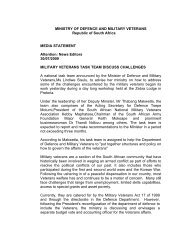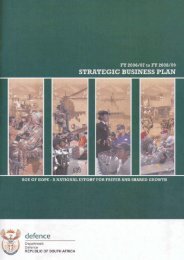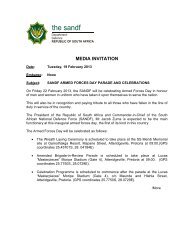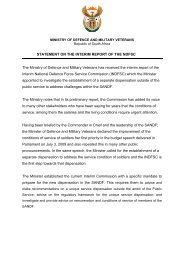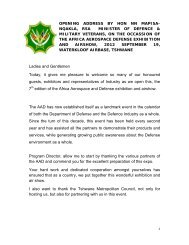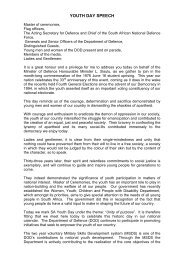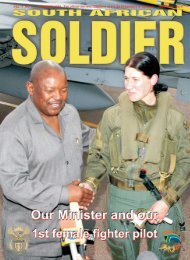You also want an ePaper? Increase the reach of your titles
YUMPU automatically turns print PDFs into web optimized ePapers that Google loves.
historyUnveiling <strong>of</strong>King Dinuzulu's Statue34Article and photo by WO1 MannyGounden, PRO Naval StationDurbanThe Premier <strong>of</strong> KwaZulu-Natal,Mr Sibusiso Ndebele,unveiled the statue <strong>of</strong> KingDinuzulu in a heavy downpourand freezing cold atBotha's Garden in Durban on20 September 2008. It was one<strong>of</strong> the highlights <strong>of</strong> the 2008 KwaZulu-Natal Heritage Programme.Parts <strong>of</strong> KwaZulu-Natal weretransformed into a "winter wonderland"after snowfalls blanketed severalareas <strong>of</strong> the province. Temperaturesplummeted into the low teens asDurban experienced its coldestSeptember in recorded history.However, the extremely cold andrainy weather did not dampen theunveiling ceremony or the attendance.The Chief <strong>of</strong> the SANDF appointedthe Chief <strong>of</strong> the SA Army as the ChiefExecutor to provide ceremonial, logisticand technical support for this historicevent. Representing the Chief <strong>of</strong>the SA Army was Brig Gen RobertMandisa, the General Officer CommandingSA Army SupportFormation.The assembled guests also witnessedthe Mayor <strong>of</strong> eThekwini Metro(Durban), Councillor Obed Mlaba,rename Berea Road as King DinuzuluRoad in honour <strong>of</strong> the king.Premier Ndebele in his addresssaid: "The statue <strong>of</strong> King Dinuzulu is aunique statue that symbolises nationbuildingand national reconciliation.The unveiling <strong>of</strong> the statue <strong>of</strong> KingDinuzulu therefore affords us all anopportunity to take a deep look at ourcollective past and what it can do toshape our present and the future. Weare telling the story <strong>of</strong> the Zulu peopleand the people <strong>of</strong> KwaZulu-Natal."S A S O L D I E R • NO VEMB ER 2 0 0 8SANDF'S ROLEThe National Ceremonial Guard ledby the SA Army Band <strong>of</strong> Durbanformed up and marched along BereaRoad. They drew tumultuous applausesfrom the crowd in heavy raincoats andsheltering under umbrellas. Historywas in the making and not even thisbleak weather was going to keep thecrowd away.The National Ceremonial Guardand the SA Army Band conductedthemselves on parade in a manner befittinga well-disciplined and pr<strong>of</strong>essionalmilitary force.Logan Maistry, the Premier'sspokesperson, said: "The presence <strong>of</strong>the SANDF here today is really appreciated.The spectacular display by theNational Ceremonial Guard and the SAArmy Band added to the success <strong>of</strong> theunveiling ceremony. It was also anopportunity for the people <strong>of</strong> KwaZulu-Natal to witness the support that isbeing received from the SANDF today."Chaplain Mabandla Nkayi fromArmy Support Base KwaZulu-Natal,who did the opening prayer, spoke withdeep conviction <strong>of</strong> the significance <strong>of</strong>this event and the recognition <strong>of</strong> the historythe Zulu people.KING DINUZULUThe story <strong>of</strong> King Dinuzulu is astory <strong>of</strong> courage, determination andsocio-political transformation. He was aking who experienced it all, but whokept on fighting for the dignity <strong>of</strong> hispeople, their land and the royal house.King Dinuzulu was born in 1868. Hebecame the King <strong>of</strong> the Zulus in May1884 following the death <strong>of</strong> his father,King Cetshwayo, in February <strong>of</strong> thesame year. During his time KingDinuzulu was known as "the modernisingking". The historian, Pr<strong>of</strong> JeffGuy, wrote in his book "A View fromAcross the River" that King Dinuzulustraddled the traditional Zulu andmodern African essence <strong>of</strong> being anAfrican. The ceremony was the culmination<strong>of</strong> years <strong>of</strong> research, consultationand the implementation <strong>of</strong> thelegacy <strong>of</strong> a man that Harriett Colensoonce described as "walking this earthas if he owns it". Such was KingDinuzulu - fearless, majestic andalways reaching out.SCRAMBLE FOR AFRICAThere were global issues at play.Dinuzulu ascended the throne in 1884and, unbeknown to him, he steppedinto these. The superpowers <strong>of</strong> the timemet in Brussels to stage the biggestcolonial scramble for land.By 1885, a microcosm <strong>of</strong> theBrussels Conference took place inZululand, with the Boers, the Germansand the British all claiming land inZululand. The scramble for Zululandwas made worse by the Zulu civil war<strong>of</strong> 1884-1888 between uSuthu andMandlakazi, when brother had turnedagainst brother. Berlin and London hadthemselves taken a keen interest in thescramble for Zululand by 1886. SoDinuzulu got attacked from all quarters.He had to spend his time defendingwhatever remained <strong>of</strong> the legacy <strong>of</strong>King Shaka. He was humiliated manytimes by the British authorities, especiallyGovernor Arthur Havelock. On 9<strong>November</strong> 1887 Havelock had a conferencewith the king. As the king wastelling him that he was the rightful successorto the throne <strong>of</strong> Shaka's kingdom,Havelock simply replied: "Such athing is now impossible. Dinzulu mustknow and all Zulus must know that therule <strong>of</strong> the House <strong>of</strong> Shaka is a thing <strong>of</strong>the past".The reconciliatory tone <strong>of</strong> KingCetshwayo was met by resistance andmissed opportunities by the British andthe colonial authorities in Natal, who




